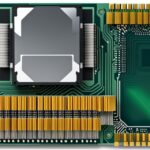Table of Contents
In the computing world, the CPU is the brain that follows instructions. It only understands machine language. This language is made of binary bits: 0s and 1s. These bits tell the computer what to do1. Machine language is the foundation for all other programming languages. They have to be translated into a language the CPU can process2. For those curious about computers and low-level programming, knowing this is key. It links directly to artificial intelligence in our high-tech world.
Key Takeaways
- The CPU exclusively processes machine language instructions, which are vital for executing programs.
- Machine language consists of binary bits, making it a low-level programming language.
- This set of instructions is crucial for the functioning of all software applications.
- A solid grasp of machine language enhances understanding of how computing systems operate.
- The evolution from machine language to higher-level languages illustrates the progress of computer language development.
What Is Machine Language?
Machine language is key to understanding how computers work. It allows hardware and software to communicate and follow instructions. The machine language definition is based on binary code, using only 0s and 1s. This makes it a low-level language, very close to computer hardware. It’s known for being efficient, accurate, and understood only by the computer’s processor3
Definition and Characteristics
Think of machine language as a simple code of 1s and 0s. These binary numbers form the executable code running inside a computer. Directly talking to the CPU, it’s remarkably fast45. Machine language is super efficient for tasks needing top speed. Yet, it’s not easy to move programs around different computers because they’re made for specific hardware3.
Role in Computing
Machine language sets the foundation for all other programming languages. For example, Java or C++ gets changed into machine language for the CPU to work with it4. This translation ensures smooth operation between various languages and the computer’s hardware. Even though it’s complex, machine language is crucial for the best performing applications, proving its timeless value in computers5.
Understanding Assembly Language
Assembly language acts as an important link between machine language and more complex programming. It lets programmers write instructions that closely match what the hardware does. This helps them understand how the CPU works better. The assembly language definition shows it as a basic programming language. It uses mnemonics that directly represent machine code.
Defining Assembly Language
Assembly language uses symbols we can read to stand for machine code instructions. Each mnemonic is a command for the hardware to carry out a task. Such tasks could be simple arithmetic or moving data. Knowing computer architecture well is key to using this language. An assembler changes these instructions into machine code, making programming easier.
Benefits of Assembly Language
Assembly language offers several advantages when efficiency and precise control are needed. It lets programmers directly manage system resources, which improves performance and uses resources wisely. Assembly-written programs are more compact, so they run faster. Also, learning this language deepens understanding of how computers work. This knowledge is very useful for creating embedded systems or in roles where speed is crucial.
| Aspect | Low-Level Programming (Assembly) | High-Level Programming |
|---|---|---|
| Translation | Assembler converts to machine code | Compiler or Interpreter translates code |
| Control over Hardware | High | Low to Moderate |
| Performance | Optimised, faster execution | Generally slower due to abstraction |
| Ease of Use | Complex, requires in-depth knowledge | User-friendly, simple syntax |
Grasping the benefits of assembly language gives programmers the skills for effective low-level coding. This opens doors to innovation in software and improves system performance. Choosing which programming language to use heavily depends on your project goals67.
The Distinction Between Machine Language and Assembly Language
Learning the difference between machine language and assembly language is key for those curious about computing. They form the core of low-level programming languages. Their differences come down to how they are structured and how easily they can be read.
Key Differences
Machine code is a set of instructions a computer’s central processing unit reads directly, using only 1s and 0s. This makes it quite fast since it’s in the language machines understand naturally8. On the other hand, assembly language uses easier-to-understand codes, referred to as mnemonics. Although it is simpler for people to read9, it needs converting into machine code via an assembler before a computer can execute it10.
- Machine Language:
- Binary format (1s and 0s)
- Quick execution
- Talks directly to CPU
- Assembly Language:
- Uses readable mnemonics
- Conversion by an assembler necessary
- Not as speedy as machine language
Examples of Each Language
Looking at examples from these language families shows why their differences matter. For instance, early machine code played a vital role in operating the UNIVAC computer8. In contrast, the IBM-PC’s assembly language uses the Intel 8086 instruction set and is still used in many areas today. While machine languages are often used in creating operating systems, firmware, and bootloaders, assembly languages are popular in game development and enhancing performance9.
| Aspect | Machine Language | Assembly Language |
|---|---|---|
| Type | First-generation language | Second-generation language |
| Format | Binary (1s and 0s) | Symbols and mnemonics |
| Execution Speed | Faster | Slower |
| Translation Requirement | No translation needed | Requires an assembler |
How Does a CPU Process Machine Language?
The central processing unit (CPU) is key in modern computing. It processes machine language through a detailed mechanism. This involves the fetch-decode-execute cycle.
The Fetch-Decode-Execute Cycle
The fetch-decode-execute cycle is a core loop for the CPU. It gets instructions from memory and decodes them. Then, it knows the specific task to do. Machine instructions tell the CPU what action to take, like arithmetic11.
For example, Firefox uses millions of such instructions for its tasks12. This lets the CPU do up to 2 billion actions a second. Its speed is truly amazing12.
Microcode and Its Role
Microcode links high-level commands and the CPU’s hardware. It changes machine language into needed control signals. This ensures tasks are done correctly by the machine code11. Thanks to this, CPUs work on complex instructions swiftly12.
Why a CPU Only Understands Machine Language Instructions
CPUs work with machine language, which is just 0s and 1s. This matches the computer’s basic on and off switches13. Such structure means CPUs find it hard to deal with complex languages. For instance, languages like Python must be translated into machine language14. This translation is key for software and hardware to communicate properly.
When a CPU understands machine language, it follows a clear process. This process is called fetch-decode-execute14. Here, microcode helps by breaking down machine code instructions14. This strict need for machine language boosts a CPU’s performance. It solidifies machine language as the basic language for all computing. This ensures that different programming languages work smoothly on various systems.
The Evolution of Programming Languages
The journey through programming languages has truly changed computing. It’s moved from simple machine language to complex high-level programming. This change has made coding much clearer for developers and opened up opportunities for more people to create new things.
From Machine Language to High-Level Programming
There are three types of programming languages: low-level, mid-level, and high-level15. Ada Lovelace made the first programming language in 1883 for the analytical engine by Charles Babbage, marking a historic moment16. Since the first assembly language appeared in 1949, to recent languages like Python and JavaScript, each step has been crucial for today’s software development.
Impact on Software Development
The move to high-level languages has changed how we develop, maintain, and update software to meet modern needs15. COBOL and FORTRAN are great examples. COBOL was used by 80% of businesses in 1997, and FORTRAN powered NASA’s Voyager missions16. Nowadays, low-code and no-code platforms let more people make software, bringing diverse ideas to the programming world15.
Conclusion
When we think about machine language, its crucial role in computing becomes evident. It’s the only language a CPU truly understands. This language lives at the heart of a computer, making efficient processing possible through binary codes of 0s and 1s17. This close bond highlights the need to grasp CPU language; it’s essential for turning high-level codes like C++, Java, and Python into actions a machine can do18.
As tech moves forward, machine language keeps its key position. It lets software and systems work at their best by controlling hardware directly. This direct link means we can keep creating powerful applications, especially in fields like embedded systems and AI19.
Understanding machine language deepens our respect for the evolution of programming. It helps us look ahead, knowing that our base knowledge in machine language will lead to breakthroughs. As we face more complex tech challenges, our grasp of machine language will guide us in enhancing CPU performance and pushing technological boundaries.
FAQ
What is the definition of machine language?
Machine language, also known as machine code or object code, is made up of bits. These bits are in binary form, meaning just 0s and 1s. This is the only language a computer can understand and execute directly. Its simplicity lets it work efficiently with the CPU.
How does machine language relate to assembly language?
Assembly language is a step closer to humans than machine language. It uses short codes, called mnemonics, to represent machine instructions. This way, it’s easier for programmers to use but still keeps control over the computer’s hardware.
Why is the fetch-decode-execute cycle important in CPU processing?
The fetch-decode-execute cycle is key to how CPUs work. First, the CPU gets an instruction from its memory. Then it figures out what the instruction means. Finally, it does what the instruction says. This process keeps the computer running smoothly and accurately.
What role does microcode play in processing machine language?
Microcode makes machine language work on the CPU. It changes machine instructions into specific signals. These signals tell the CPU how to execute the commands. This lets complex instructions run well on the hardware, boosting the computer’s performance.
Why do CPUs exclusively comprehend machine language?
CPUs are built to only understand machine language. Machine language uses binary, which is very efficient for computers. This simplicity helps the CPU work better. High-level languages must turn into machine language before the CPU can execute them. This makes machine language the universal computer language.
How has the evolution of programming languages impacted software development?
The shift from basic machine language to advanced languages like Python and Java has changed software development. It made coding more accessible to many people. This change led to new ideas and better ways to make and look after software.
Source Links
- https://www.geeksforgeeks.org/what-is-machine-language/ – What is Machine Language? – GeeksforGeeks
- https://www.spiceworks.com/tech/tech-general/articles/machine-vs-assembly-language/ – Machine Language vs. Assembly Language | Spiceworks – Spiceworks
- https://www.sciencedirect.com/topics/engineering/machine-language – Machine Language – an overview
- https://stackoverflow.com/questions/43425225/what-actually-is-the-machine-language – What actually is the machine language?
- https://www.cs.mtsu.edu/~xyang/2170/computerLanguages.html – Machine Language/Assembly Language/High Level Language
- https://stackoverflow.com/questions/49489376/how-does-assembly-code-actually-get-interpreted-at-the-basic-level – How does assembly code actually get interpreted at the basic level?
- https://stackoverflow.com/questions/5382130/are-instruction-set-and-assembly-language-the-same-thing – Are instruction set and assembly language the same thing?
- https://stackoverflow.com/questions/40071224/what-is-the-difference-between-machine-instructions-and-assembly-instructions – What is the difference between machine instructions and assembly instructions?
- https://unstop.com/blog/difference-between-machine-language-and-assembly-language – Difference Between Machine Language & Assembly Language
- https://byjus.com/gate/difference-between-machine-language-and-assembly-language/ – Difference Between Machine Language and Assembly Language
- https://www.geeksforgeeks.org/machine-instructions/ – Machine Instructions – GeeksforGeeks
- https://web.stanford.edu/class/cs101/software – Software
- https://medium.com/the-ui-girl/some-computer-science-questions-7c1056909757 – How the computer understands programming languages…
- https://stackoverflow.com/questions/9753669/how-does-machine-code-communicate-with-processor – How does machine code communicate with processor?
- https://medium.com/@amitvsolutions/history-evolution-of-programming-b2f528e6820d – History & Evolution of Programming
- https://www.geeksforgeeks.org/the-evolution-of-programming-languages/ – The Evolution of Programming Languages – GeeksforGeeks
- https://ms.codes/en-gb/blogs/computer-hardware/a-cpu-only-understands-machine-language-instructions – A CPU Only Understands Machine Language Instructions
- https://web.stanford.edu/class/cs101/software-2.html – Software-2 Languages
- https://tokyotechlab.com/blogs/ngon-ngu-may – What is Machine Language? Applications of Machine Language












